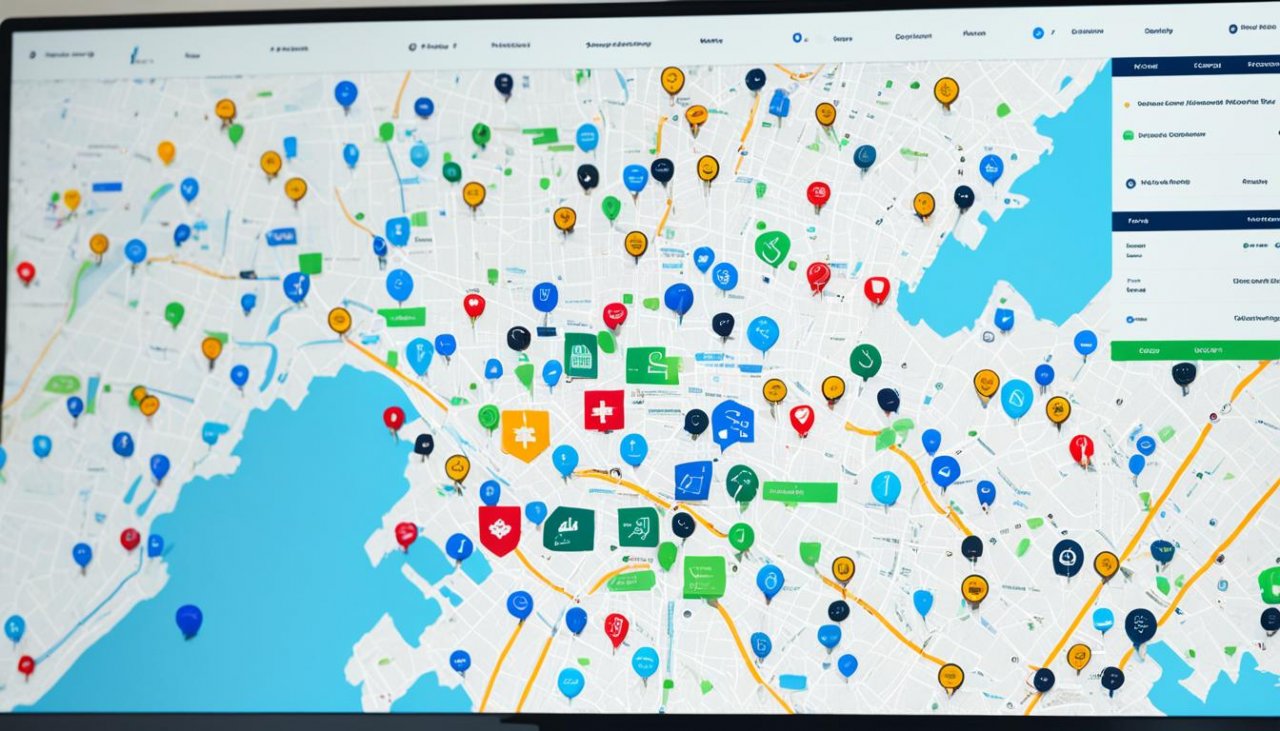Did you know that inefficient route planning can cost a field service business up to 30% of its total operating expenses?
Good route planning is key for field service businesses to thrive. It boosts efficiency, cuts costs, and cheers up customers. Getting details on services, where technicians are, work orders, and traffic is the beginning. Then, looking at old info to see trends helps in making smart route choices.
Choosing the right route planning software is important. Look for features like traffic updates, finding the best order for stops, and connection to CRM tools, like FieldAx-Field Service Software. This kind of software can make planning routes easy. It groups stops based on what’s most urgent, nearby, and the skill of the techs. Remembering when customers are home for service lessens missed visits.
Knowing real-time traffic and weather can mean changing routes to avoid hold-ups. Having backup plans gets you ready for road closures or bad weather. It’s also good to share work evenly and give techs good navigation tools. Checking how routes go and how techs do helps spot areas to make things better.
Keeping up with new tech and changing plans as services grow is a must. Keeping customers posted on when to expect your team and using automated messages makes people happy. Plus, listening to what techs say and using their advice helps make route planning better over time. This leads to a leaner, meaner operation overall.

Key Takeaways:
- Efficient route planning is crucial for the success of field service businesses.
- Choosing reliable route planning software that offers real-time traffic updates and multiple-stop optimization can streamline the route planning process.
- Taking into account specific time windows and categorizing service stops can reduce missed appointments.
- Real-time traffic and weather information improve on-time performance and help avoid delays.
- Regularly tracking route performance and technician efficiency allows for data analysis and continuous improvement.
The Importance of Efficient Route Planning in Field Service Operations.
Efficient route planning is key to the success of field service work. Technologies like GPS tracking and route planner apps better our travel routes. They help cut travel time and the distance we need to go.
These tools also let businesses keep track of their workers in real-time. They update where technicians are and help spread the work out well. So, jobs are done quicker and more effectively.
By using these tech tools, we do more in less time. This cuts costs and makes customers happier. Having a mobile workforce system that includes route planning makes things run smoother.
With GPS tracking, businesses always know where their technicians are. This means workers can take the fastest route and not get lost. It saves time and energy.
Route planner apps suggest the best ways to get to places. They look at things like traffic and road work. This helps technicians get to their jobs on time, making customers happier with the service.
Mobile management mixes GPS and route apps for a full service solution. It sends workers where they need to go, tracks their progress, and adjusts for any roadblocks.
With good route planning, businesses run better. They’re more efficient, save money, and keep customers happy.
Streamlining Field Service Operations with Efficient Route Planning
Good route planning makes the whole service system better. It reduces travel time and plans jobs smartly. This makes the most of resources, saves gas, and cuts down on vehicle damage.
It’s also key in keeping customers happy. Giving accurate times and sticking to schedules boosts customer satisfaction. Automation in route planning even updates customers about when to expect the service.
In the end, smart route planning with the latest tech is a must for service work. It helps businesses do more in less time, saving money while keeping customers satisfied. This approach gives services an edge in today’s competitive market.
The Benefits of Route Optimization in Field Service.
Route optimization is key in field service, bringing huge benefits for businesses. By using automation and efficient routing software, firms can cut down on costs and boost productivity. This leads to better service and higher profits.
Optimizing routes saves both time and resources. It gets rid of manual route planning, letting businesses use their resources better. Routes are planned considering traffic, technician availability, and when services can be done, cutting down on travel time. This means technicians finish more jobs in the same time. It boosts productivity and makes customers happier.
Also, route optimization helps save money and use resources better. Thanks to good routing software, businesses can create routes that save on gas and lessen vehicle wear. This keeps fuel and maintenance costs low. It ensures tasks are given to technicians near a job and who have the right skills, making the most of resources.
Route optimization not only makes operations smoother but also lifts customer satisfaction. Less travel time and arriving on time help meet customer needs. Happy customers tend to come back and spread the word, building a company’s good name in the field service sector.
Image related to route optimization

In the end, optimizing routes with automation and efficient software is a big win for companies. It cuts down on wasted time, saves money, and keeps customers happy. A strong optimization plan is crucial for businesses wanting to do well in the competitive field service market.
How Real-Time Traffic Information Enhances Route Planning.
Real-time traffic updates change how we plan our routes, especially for field services. They let businesses adjust routes on the go to bypass traffic. This helps technicians arrive on time and cuts down on delays.
Aside from avoiding traffic, businesses also use smart route planning. They track current traffic and choose the best ways for their technicians. This efficient route selection means quicker service and happier customers.
FieldAx-Field Service Software is a great example of this. It offers real-time traffic data and smart route tools. With this software, businesses can keep their routes updated, saving time and money.
Improving On-Time Performance
Real-time traffic updates are key for getting technicians to jobs on time. Being able to reroute around traffic issues means less waiting for customers. This boosts satisfaction and efficiency for the business.
Minimizing Delays and Optimizing Efficiency
Using real-time traffic data, businesses can cut delays and work more efficiently. They pick routes that avoid traffic, which speeds up their trips. This leads to getting more jobs done in less time, increasing overall work output.
For example, imagine a technician is headed to a job and runs into sudden traffic. Real-time updates mean the software can find a quicker path, keeping the tech on schedule. This shows how important real-time updates are for smooth operations.
The Role of Data Analysis in Optimizing Route Planning.
Data analysis is key in making field service operations run smoothly. It looks at past data to find patterns and trends. This helps companies make better choices in planning routes. They end up spending less and working better.
Looking at data can also predict when machines might break. By checking on how machines act and their repair history, companies can spot problems early. This helps them fix things before they cause a big issue. So, they avoid having to rush and make emergency fixes.
Adding data tools to planning makes businesses better all the time. They look at past schedules, traffic, and times for service. Then, they pick the best routes that use less time. This means happier customers and more jobs finished on time.
Data can also show companies where they need to be better. By watching how routes are done, how workers work, and what customers say, companies see what’s not working well. They find places to improve, like speeding up services or making customers happier.
For example, data can help plan when machines need a checkup. By studying how machines work, businesses know when to have a look at them. This stops the machines from breaking down when not expected. So, companies can be sure their machines work well.
To sum up, using data smartly greatly helps in making routes better for services. It allows companies to plan well, fix things before they go wrong, and always look for ways to be better. With good data practices, companies can do their tasks more efficiently, making everyone happy.

The Impact of Navigation Tools on Route Planning.
Using navigation tools is key for efficient route planning. They help make field service operations better. By giving technicians GPS or using apps in planning software, businesses make sure their workers take the best and shortest paths. This reduces their travel time and makes their routes more efficient overall.
GPS devices and mobile apps are important for guiding technicians. They offer real-time directions, perfect for new areas or when there’s traffic. Thanks to these accurate tools, technicians get to their job sites quicker. This means less waiting and better service.
Not just for saving time, these tools also help businesses keep track of route quality and how well their technicians are doing. They can look at travel times, distances, and more to find ways to do better. By learning from this data, companies optimize their routes. This means happier customers in the end.
Integrating navigation tools with other tracking systems can provide even more insights. This approach highlights where extra training or support is necessary. By keeping a close eye on performance, businesses are able to improve continuously. This leads to better field service operations over time.
The Role of Route Performance Tracking
Tracking route performance is crucial for making plans better. It lets businesses see how their routes are working and where to make changes. With the right data, they can keep their services sharp and efficient. Route performance tracking helps businesses in several ways like:
- Spotting problem areas and times with traffic
- Checking how well technicians are working
- Understanding how different routes affect performance
- Making smart choices to make routes better
By keeping an eye on how routes are doing, businesses learn a lot. They can see trends and find new ways to be more efficient. This smart, data-driven approach ensures they use their resources well. It helps them offer top-notch service every time.
The Benefits of Navigation Tools
Navigation tools bring several advantages to businesses that use them:
- Better travel times and efficiency
- Less waiting and missed appointments
- Higher technician output and job satisfaction
- Smarter use of resources
By providing technicians with navigation tools, businesses see big improvements in their services. Workers can move through their routes quickly, saving time and avoiding delays. This means more tasks can get done, boosting both productivity and customer happiness.
In addition, these tools help in wisely assigning tasks. By pairing navigation tools with route planning, businesses can choose the best technician for each job nearby. This reduces overall travel time and makes the best use of available resources.
Overall, navigation tools greatly enhance route planning in field service work. They help workers move more effectively, ensure resources are used well, and improve satisfaction among customers.
The Role of Customer Communication in Route Planning.
Effective customer communication is key in making route planning better for field service work. By telling customers about estimated arrival times and possible delays, businesses satisfy more customers and set clear expectations. Using automated notifications helps companies update customers in real time, giving them the latest info and preventing missed appointments.
Customers like knowing when a technician will show up. It makes things clear and reliable, which is critical for keeping customers happy. By using automated messages, companies can set accurate estimated arrival times. This means customers aren’t left upset by late or missed appointments.
Automated alerts are a big help when things suddenly slow down. If a technician gets stuck in traffic or faces a surprise, the system can text the customer with a new time. This smart move keeps the customer happy and shows the company cares about great service.
Focusing on customer updates in the planning process boosts the whole service experience and the business’s image. Customers like being in the know and having power over the service process. Through automated updates and precise estimated arrival times, businesses can do this and earn their clients’ trust.
Incorporating Technician Feedback in Route Planning.
In the field service world, making routes better is key to run smoothly and be more efficient. Technicians, who are the face of the service, know best about what works on the ground. They offer insights on how to improve routes.
When you let technicians share their thoughts on routes, it doesn’t just give them a voice. It also helps companies keep getting better at planning routes smarter. This teamwork approach makes route planning more efficient. It’s crucial for a successful route planning strategy to include their ideas.
Businesses have many ways to get this feedback from technicians. They can use meetings, surveys, or specific online spaces for communication. These tools let technicians talk about what they see, suggest, and the roadblocks they face. Acting on this feedback means fixing problems, making routes better, and keeping the service top-notch.
Feedback from technicians often shines a light on useful things like traffic info or how to meet customer needs better. This info can help tweak routes, improve when technicians work, and make the whole service operation smoother.
The Benefits of Incorporating Technician Feedback
Letting technicians be part of planning brings many advantages.
- Improved Route Efficiency: Technicians know the best ways to go, like shortcuts and how traffic flows. Using their advice makes routes faster and more efficient, which beats service goals.
- Enhanced Customer Satisfaction: Technicians understand what customers need because they talk to them. Their insights help plan routes that meet these needs, setting the stage for happy customers.
- Increased Technician Productivity: Happy, engaged technicians work better. Companies can craft routes that fit technician skills and life outside work. This leads to more work done well and happier teams.
- Continuous Improvement: Technicians’ thoughts give companies clues on how to get better. By using this feedback to adjust routes over time, businesses can stand out. They can meet changing customer demands and shifts in the market proactively.
By listening to technicians and including their ideas in route plans, companies build a culture of working together and always getting better in the field service world.
Conclusion
Route planning is crucial in the field service world. It enables businesses to work more efficiently and achieve better results. By using analysis, tools, and smart planning techniques, companies can cut costs, work faster, and make customers happier.
They can use GPS, apps, and digital management systems to better plan their routes. This not only saves time but also cuts down on mistakes. By checking route data regularly, updating plans with new traffic info, and listening to what their staff tells them, they can keep getting better at what they do.
Good communication with customers is also key. It helps people know when technicians will arrive and if there are any delays. This makes the service experience much better.
Overall, successful field service planning depends on making smart, tech-savvy, and customer-focused choices. By following the advice in this guide, businesses will plan their routes better, save money, and offer great service. With dedication and a focus on always getting better, they can really stand out in the field service world.
See how FieldAx can transform your Field Operations.
Try it today! Book Demo
You are one click away from your customized FieldAx Demo!
FAQ
Why is efficient route planning important for field service business success?
Good route planning cuts costs and boosts productivity. It also makes customers happier with quicker service.
How can GPS tracking and route planner apps optimize field service operations?
GPS and route planning apps show where workers are. They make sure jobs are handed out well. This makes managing teams on the move better.
What are the benefits of route optimization in field service?
Route optimization saves time, money, and makes sure workers get to places on schedule. It also uses resources like vehicles and workers better.
How does real-time traffic information enhance route planning?
Keeping an eye on live traffic lets businesses change routes on the go. This avoids traffic jams and shortens travel time.
What is the role of data analysis in optimizing route planning?
Looking at data helps find trends, foresee when equipment might break, and plan maintenance checks before there are problems. This makes planning routes more efficient overall.
How do navigation tools impact route planning?
Navigation tools help workers find the fastest and best routes. This makes jobs quicker and uses less time for travel.
How does customer communication affect route planning?
Talking well with clients by telling them when to expect service or sending automatic updates makes them happier. It sets their expectations right.
Why is it important to incorporate technician feedback in route planning?
Technicians know firsthand about the best and worst routes. Their feedback helps in making continuous improvements in service operations.
How can efficient route planning contribute to field service business success?
Better operations and satisfied customers are key to business success. Efficient route planning plays a big part in achieving these goals.
Author Bio
Co-Founder & CMO at Merfantz Technologies Pvt Ltd | Marketing Manager for FieldAx Field Service Software | Salesforce All-Star Ranger and Community Contributor | Salesforce Content Creation for Knowledge Sharing






